|
The
|
THE BURGENLAND BUNCH NEWS - No. 289 July 31, 2018, © 2018 by The Burgenland Bunch All rights reserved. Permission to copy excerpts granted if credit is provided. Editor: Thomas Steichen (email: tj.steichen@comcast.net) BB Home Page: the-burgenland-bunch.org BB Newsletter Archives: BB Newsletter BB Facebook Page: TheBurgenlandBunchOFFICIAL Our 22nd year. The Burgenland Bunch Newsletter is issued monthly online. The BB was founded by Gerald Berghold, who died in August 2008. |
| Current Status Of The BB: * Members: 2658 * Surname Entries: 8388 * Query Board Entries: 5733 * Staff Members: 15 |
|
1) THE PRESIDENT'S CORNER (by Tom Steichen)  In
this month's collection of bits and pieces in Article 1, I start off
with some member responses to last month's articles. I continue with info on new records at
FamilySearch, a few snippits from ORF News (on growing hops and buying railroad
tracks), and some words on the 2020 Census. In
this month's collection of bits and pieces in Article 1, I start off
with some member responses to last month's articles. I continue with info on new records at
FamilySearch, a few snippits from ORF News (on growing hops and buying railroad
tracks), and some words on the 2020 Census.Article 2 talks about Finding "Stuff" in (Digital) Microfilms. Not surprisingly (especially given that records are in German, Hungarian and Latin), our newer members have trouble finding some records, even though they are on a film. This article is intended to help navigate to the desired records. Article 3 treats us to another exposition from BB member Richard Potetz, who writes about Date-of-Birth Errors—Roadblocks, Dead Ends, and Brick Walls. Understanding 'what can go wrong' is the first step to overcoming these problems... Richard explains the typical sources of such errors and gives approaches for resolving the problems that result. Article 4 has us off in Ireland, where writer Michael O’Loughlin gives his Ten Rules for the Returning Emigrant. As I note in my introduction to it, "I suspect at least some of these "rules" apply to Burgenland." Have a read and see if you agree! The remaining articles are our standard sections: Historical Newsletter Articles, and the Ethnic Events and Emigrant Obituaries sections. Responses To Articles: I received a couple of comments in response to articles I published last month... first, concerning Historical BB Newsletter article "Was Meint 'Heimat'? How Is 'Heimat' Defined?" ...where I said of Minnesota: "...it's my Heimat... where is yours?"  Ilse
Nusbaum wrote: "For my Opa (mother's father), Heimat was his village,
Markt Piesting, in Lower Austria. Last week he was honored with the dedication of the Dr.
Jakob Braun Promenade, a riverwalk along the Piesting River." Ilse
Nusbaum wrote: "For my Opa (mother's father), Heimat was his village,
Markt Piesting, in Lower Austria. Last week he was honored with the dedication of the Dr.
Jakob Braun Promenade, a riverwalk along the Piesting River."Richard Potetz wrote: "Heimat for me is now Granby, CT, where I know and interact with many people. Fifty years of just being here has made me a Granby person by osmosis. New Britain, where I was born and raised, is something else because of wonderful memories. But the wonderful part is just memories: factories torn down, forest land long ago cleared for a baseball park and new high school. 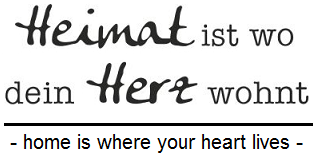 My
schools are gone. The streets where I roamed free are no longer completely safe as they were. My
schools are gone. The streets where I roamed free are no longer completely safe as they were.Burgenland was the Heimat for my parents, but really their Heimat was mostly memories. My parents’ Burgenland stories were very different from the Burgenland they visited in 1978: one room schools replaced by a combined school, school buses, recycling bins on door steps, electricity, indoor plumbing, store-bought bread, etc. Editor: Writer Thomas Wolfe, had his lead character in You Can't Go Home Again (1940) say: "You can't go back home to your family, back home to your childhood ... back home to a young man's dreams of glory and of fame ... back home to places in the country, back home to the old forms and systems of things which once seemed everlasting but which are changing all the time – back home to the escapes of Time and Memory." Richard Potetz certainly echoes that sensibility in his comments—both for his parents and for himself—yet he puts different titles to the childhood home... his being just a memory (his Heimat moved on), but his parents' childhood home still being their Heimat, if only in memories. Ilse Nusbaum perhaps says as much by avoiding the personal question (where is her Heimat?), instead speaking only of her grandfather. She does not say present-day home (Los Angeles) is her Heimat and she can't say anti-Jewish pre-WW-II Austria is either. The other article that provoked a response was "More Data from the Historisches Ortslexikon," 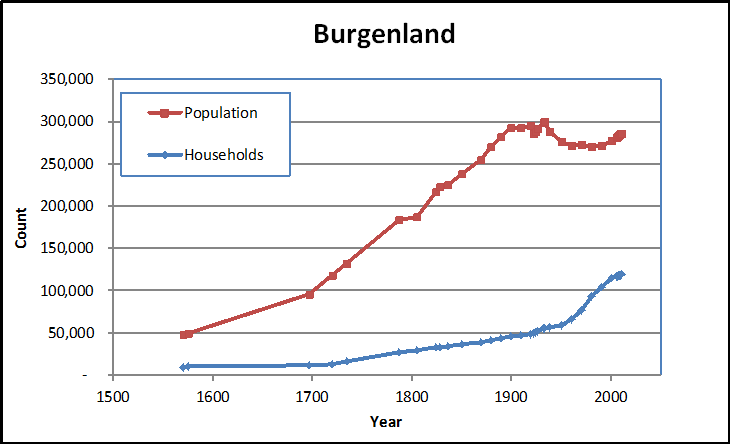 in
which I asked for opinions on why the Burgenland population data changed in the way they did. in
which I asked for opinions on why the Burgenland population data changed in the way they did.[Note: Before I get to that comment I want to remind you that, due to an error in the original version, I corrected and republished that article on 2 July 2018. The first version of the article incorrectly spoke of "farms" but the edited version uses the correct settlement unit, "households." Correcting that error caused changes in my text, graphics and analysis. So, if you read the article before the above date, you should re-read the section concerning the "overall population data." I thank Bernhard Hammer for pointing out the problem. I'll also note that the following comment arrived before the correction was published. However, its comments were directed at data and analyses that were unaffected by the editing, so remain valid. I'll also note that, since I was editing already, I made an additional tweak to the article to incorporate an idea prompted by the comment. My thanks to Richard for that!] Richard Potetz wrote: "I think there are multiple causes for population changes. Modern medicine and modern medical knowledge about germs, typhoid, etc. reduced the death rate of children in a big way. Emigration took away 30 thousand just going to the US alone, according to what I have read in the BB newsletter: 'Harvard Encyclopedia of American Ethnic Groups estimates 40,000 Burgenland immigrants arrived in the US between 1880-1924 (with perhaps 25% return).' Canada, South America, England, Australia, New Zealand, Switzerland, Germany etc. received lots of people from Burgenland too. More recently, and perhaps the biggest cause of population change, is birth control and a culture change with people favoring small families, or no children at all." Editor: What I added to the article, based on the above comment, was two-fold: first, the pre-1900 emigration did not seem to affect the Burgenland population trend in any discernable way (it continued the same linear growth path up to 1900) ...but perhaps that pre-1900 emigration was overwhelmed by the increased survivability due to the medical advances that Richard noted. Secondly, the post-1900 population remained flat despite these medical advances ...in this case, perhaps the greater post-1900 emigration, plus the loss of procreative-age adults due to the early emigration, fully countered the effects of increased survivability. In addition, an additional 19 million indexed records and 1.9 million images from around the world were added in June. While none of these were Burgenland-specific, their broad reach suggests at least some likely apply to your research interests! Hop-Growing in Southern Burgenland Planned: ORF News ran a short bit this past month about the potential for growing hops in southern Burgenland. Currently, Austrian hops are grown mainly in select regions in Upper and Lower Austria and Styria. According to the Burgenland Chamber of Agriculture's Manfred Gsellmann,  hops
could also grow in southern Burgenland, becoming a new mainstay for farmers. hops
could also grow in southern Burgenland, becoming a new mainstay for farmers.Gsellmann explained that the hops plant does not thrive everywhere. Soil, weather and climate must be right... and the climate in southern Burgenland is basically suitable for its cultivation. "Only the rainfall could be a problem, but if like this year, it would certainly be ideal for hop growing," said Gsellmann. The interest in growing hops is motivated because more and more small private breweries are being set up in southern Burgenland, and "that these businesses could source the basic products from the region," says Gsellmann. Given that, an excursion to southern Styria is planned for August to show interested farmers how to grow hops and to make them tasty. During this excursion, the farmers will be familiarized with the cultivation, care, fertilization, harvest, drying and storage of hops. Burgenland Buys Another Section of Railway: In past newsletters I've mentioned that Burgenland receives funds from the EU's "Interreg" (for "Inter-region") program to support Burgenland-Hungary cross-border road and railroad improvements.  Given
that, various projects are currently under construction that will allow Burgenland products
greater access to Hungarian markets and will bring more Hungarian tourists to Burgenland spas
and resorts. Given
that, various projects are currently under construction that will allow Burgenland products
greater access to Hungarian markets and will bring more Hungarian tourists to Burgenland spas
and resorts. In addition to and in conjunction with those efforts, a Burgenland transportation infrasucture government unit, Verkehrs Infrastruktur Burgenland, has been buying unused sections of railway in Burgenland and reopening them for commerce. The latest addition is 8.4 km of rail between Unterwart and Großpetersdorf in the Oberwart district, which connects to a 24 km section from Friedberg (just in Styria) to Oberwart that was purchased a year ago. The immediate goal is to provide rail service to Sägewerk Fischer (the Fischer Sawmill) in Rotenturm and to relocate timber loading away from Oberwart. In the near future, other businesses in the corridor are expected to take advantage of the new rail service. However, the long-term goal is to restore the rail link to Szombathely, using Interreg funding, and provide both passenger and freight cross-border services.  US
Census Bureau Begins Recruitment for 2020 Census Workers: The 2020 US Census will
require hundreds of thousands of diverse but temporary workers to follow up by phone or in
person with households that do not respond to the census questionnaire. US
Census Bureau Begins Recruitment for 2020 Census Workers: The 2020 US Census will
require hundreds of thousands of diverse but temporary workers to follow up by phone or in
person with households that do not respond to the census questionnaire.Before hiring begins, the Census Bureau needs to assemble an applicant pool in the millions (for the 2010 Census, it recruited approximately 3.9 million job applicants). In some areas, the Census Bureau will need applicants who are fluent both in English and another language, which can be a challenge. Thus their emphasis will be on competitive and attractive pay rates as well as an easy application process. However, job offers will be contingent upon applicants passing a background check (including fingerprinting). Although applications are not being taken yet, if you are interested in applying, you can sign up for the latest info here: Census Jobs email updates.  Update
for book "The Burgenländer Emigration to America": Here is this month's update on
purchases of the English issue of the 3rd edition of Dr. Walter Dujmovits' book "Die
Amerika-Wanderung Der Burgenländer." Update
for book "The Burgenländer Emigration to America": Here is this month's update on
purchases of the English issue of the 3rd edition of Dr. Walter Dujmovits' book "Die
Amerika-Wanderung Der Burgenländer."Current total sales are 1317 copies, as interested people purchased 8 more books during this past month. As always, the book remains available for online purchase at a list price of $7.41 (which is the production charge for the book, as we purposely choose not to make a profit so we can avoid dealing with the income tax consequences and so you can obtain the book at as low a cost as possible!), plus tax & shipping. See the BB homepage for a link to the information / ordering page and for information about current discounts (there is at least one discount on price or shipping available most of the time... if not, wait a few days and there will be one!). Burgenland Recipes: This is a family recipe from contributor Steve Lamberty, whose roots are in Schandorf in southern Burgenland. While there are similiarities to the recipes in BB newsletter 125, an important difference in this one is that the sour cream is added after all of the cooking is done, which helps safeguard against it curdling. The other thing that may be appealing is that this recipe uses boneless, skinless chicken, which makes for much easier eating!  CHICKEN
PAPRIKASH(from Steve Lamberty) CHICKEN
PAPRIKASH(from Steve Lamberty)Ingredients: 1 cup sour cream 1 1/2 cup chicken broth 1 onion, chopped or 1 tsp. onion powder 1 lb. boneless, skinless chicken thighs 1 lb. boneless, skinless chicken breasts 2 Tbsp. flour 1/4 cup butter 1 tsp. black pepper 3 Tbsp. Hungarian sweet paprika Preparation: 1) Measure out 1 cup of sour cream and put to the side until later. 2) Prepare chicken broth, unless using a can or carton. 3) Chop an onion into medium-sized pieces. 4) Cut chicken into small pieces (2 in.) and dredge in flour. Cooking: 1) Melt the butter in a skillet. Add chicken, onion/onion powder, pepper and paprika. Cook until lightly brown. 2) Add chicken broth, simmer. Cook until chicken is done. 3) When done, cool chicken mixture slightly, then add the sour cream. Stir until well blended. Serving suggestion: Serve over egg noodles or Spätzle.  Reminder:
We no longer have a "regular" source for Burgenland recipes. As evidenced above, a few readers
have shared favorite family recipes, and we do have a reserve for a couple of months now, but if
contributions stop coming in, we'll be begging again! So, please consider sharing your favorite
Burgenland recipes or recipe books with us. Our older relatives sadly aren't with us forever, so
don't allow your allow your favorite ethnic dishes to become lost to future generations. Send
your suggestions to BB Recipes Editor,
Alan Varga. Thanks! Reminder:
We no longer have a "regular" source for Burgenland recipes. As evidenced above, a few readers
have shared favorite family recipes, and we do have a reserve for a couple of months now, but if
contributions stop coming in, we'll be begging again! So, please consider sharing your favorite
Burgenland recipes or recipe books with us. Our older relatives sadly aren't with us forever, so
don't allow your allow your favorite ethnic dishes to become lost to future generations. Send
your suggestions to BB Recipes Editor,
Alan Varga. Thanks!Cartoon of the Month:  |
2) FINDING "STUFF" IN (DIGITAL) MICROFILMS Every so often, I receive a message from a member suggesting that a description we provide on our LDS pages about a Burgenland microfilm may be wrong. In some cases, the member is correct, so I thank him/her for telling me about it and then quickly edit the description to be accurate (such errors usually occur because LDS did not correctly describe the film in their catalog, which was the source for our descriptions). In other cases, the description is adequate but our member still failed to find the records of interest. This usually occurred when the member was looking for marriage or death records on a film that carried multiple type of records (births, marriages, deaths). Burgenland records are usually arranged in one of two ways: 1) by year, with births, marriages and deaths (almost always in that order) presented for one year, before the same triplet is provided for the next year, etc.; and 2) by type (birth, marriage or death), with multiple years of each type presented before switching to the next type. You can discover which arrangement a film has by looking at the header records on the film (note: a few films do not have header records). In the example below, the fourth image has the information we want: 
It
is useful to compare the folio information on this page with the image count presented by
the image viewer (see right for this film).
Should the folio count differ greatly from the image count, it usually implies
one of a few possibilities:
|
3) DATE-OF-BIRTH ERRORS—ROADBLOCKS, DEAD ENDS, AND BRICK WALLS (by Richard Potetz)  People new to genealogy often build their trees easily until they reach an immigrant ancestor, then falter when trying to connect to European records. The problem is magnified if the date of birth used by their  immigrant
ancestor in America was not their actual birth date. “Roadblock,” “dead end”
and “brick wall” are all terms used by genealogists immigrant
ancestor in America was not their actual birth date. “Roadblock,” “dead end”
and “brick wall” are all terms used by genealogists
 when
they can’t trace an ancestor. Surname spelling variations are usually the culprit, but incorrect
birth dates are a big cause too. Date-of-birth errors are not as rare as you might expect. From
my small group of immigrant relatives there are three examples. when
they can’t trace an ancestor. Surname spelling variations are usually the culprit, but incorrect
birth dates are a big cause too. Date-of-birth errors are not as rare as you might expect. From
my small group of immigrant relatives there are three examples.Wrong Birth Year My father's uncle, Frank Potetz, was born 26 Oct 1885, but 1886 is engraved on his cemetery marker. His actual birth date in Burgenland is clear, recorded at the Sankt Martin an der Raab church:
It’s his records in America that are wrong: his age in the US census records and his year of
birth in documents like his World War II draft registration, which read 26 Oct 1886. His
published obituary continues the error, claiming he was 75 when he actually was 76. Considering
the person, the error is a surprise.
Mary’s wedding record, recorded in the Farkasdifalva (Neumarkt an der Raab) Hungarian civil registration, also correctly shows her birth date as 12 Jan 1878:
From the time of that marriage to the time Mary (Zotter) Wohinz arrived in America, the pace of events in her life was enough to make anyone unsure of their birthdate.
What a busy ten months! When Mary applied for naturalization a few years later, her birthdate
typed onto the form, 6 Jan 1878, was likely her best guess at the time, off by just six
days. Worse than that though, on her burial marker in Saint Mary’s cemetery in New Britain, her
year of birth is also wrong, recorded as 6 Jan 1879.
That last piece of information is important; showing the date of the old name day can differ from the present feast day of that saint. Seeking more information, the question below was asked of Burgenland Bunch staff member Fritz Königshofer, who has knowledge of life in Burgenland:
Fritz replied:
So now we have an excellent reason for those date-of-birth errors: an example of an author
who celebrated his name day and did not celebrate his birthday nor even make note
of it. Even more telling is the author’s tale of searching the parish book to learn his birth
date. Our immigrant ancestors lived too far away to search the parish book. |
4) TEN RULES FOR THE RETURNING EMIGRANT Editor: While looking for something else, GoogleSearch dumped me on 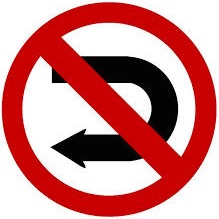 The
Irish Times page, dated Jan 9, 2018, and an article, entitled as above, by Michael
O’Loughlin, who is listed as a writer and poet. The
Irish Times page, dated Jan 9, 2018, and an article, entitled as above, by Michael
O’Loughlin, who is listed as a writer and poet.Although the article is about Ireland and its re-emigrants, number one, it made me laugh! ...and I thought I'd share that laugh with you; number two, I suspect at least some of these "rules" apply to Burgenland, should you wish to permanently return (O'Loughlin is addressing those kind of returnees, not touristy visitors... those kind are quite welcome there [as they are in Burgenland!]). Enjoy... O’Loughlin writes: Planning on coming home to Ireland in 2018? Think again for it will be a mistake. 1. Don’t come back. 2. If you decide to come back anyway, remember that returning is the Great Irish Solecism (Ed: a breach of good manners; a piece of incorrect behavior). Never forget, we don’t want you. Here in Ireland people talk about the diaspora, write about the diaspora, there’s even a Minister for the Diaspora. The word diaspora originally referred to the dispersal of the Jewish population of Israel around the world. But for Israel, diaspora has its counterpart in “aliyah”, or the return to Israel. You never hear anyone in Ireland talk about aliyah. There is no Minister for Aliyah. If even a small percentage of the people who have left Ireland, and their descendants, were to return, chaos would ensue. If a sizeable percentage of the Irish diaspora were to make aliyah, the institutions of the State would collapse. 3. Don’t be fooled by the surface welcome, the tears and smiles at the airport. The State has not planned for your return, has made no provision for your health, your housing, your old age, or your children’s right to the education of their choice. The returned emigrant is not just another hungry snout in the limited trough, but a constant reminder of the existential fragility of the State, the vulnerability of its future. You will always make people a little nervous and resentful. You have failed to obey the holy commandment of the emigrant: stay away. 4. Having returned, do not, under any circumstances, ever mention any experience you have acquired, or anything you have learned, in your time outside Ireland. No thank you, we do not want to hear about the healthcare system in France, or rent control in Berlin, or wind power production in Canada. If you liked it so much, why didn’t you stay there? (Likewise, pretend to not speak any foreign languages. Otherwise people will suspect you of notions.) 5. When you return, do not be amused. In the beginning you will be easily amused by the absurdities and Irishisms. You will be tempted to store them away as anecdotes to dine out upon abroad for years to come. The one about the school which asks you where you go to Mass. The one about the school project which regrets they can’t admit your children because you didn’t put them down on the waiting list when they were born, 15,000 km away. Laugh while you still can, but you will pay for it. These people are not joking. Never forget: Ireland will soon wipe the smile off your face. 6. Be prepared for moments of complete disbelief. Remember those people in your class/college year, the ones with the wrong jeans and the middling marks, and the large complacent smiles, the sons and daughters of politicians, solicitors, auctioneers and doctors? Well, in your absence they have inherited the country, as they always expected they would. You gave them a free run. By staying in the same place, by standing still, they have risen inexorably. Inevitably, you will run into them, and they are not prepared to get out of your way.  7. Do not get into drunken late-night arguments in Connemara hotel bars with a group of dentists from Dublin who tell you the reason the Irish have such bad teeth is that the country is too small to pay for good teeth for everyone. You have to stop referring to Finland or Denmark, or even Iceland. 8. Radically revise your notions of success and failure. In Ireland, nothing succeeds like failure. The top ranks of society, in politics, in the media, in the professions, are filled with people who have consistently failed to achieve anything, except keeping their noses clean and the boat unrocked, and each failure is rewarded with promotion. Get elected to the Dáil, do nothing for years, get promoted to Minister, do nothing for years. 9. Do not, for one moment, believe the hype. Never forget that underneath the PR and the branding and rebranding, the novelty socks and the grinning plausibility, this is still a banana republic, even if they are now digital bananas. The centrality of emigration to the State’s continued existence remains unchanged. As the Irish politician Brian Lenihan once said “We can’t all live on a small island.” In the event of the always-inevitable crisis, it is not social change and a reorganisation of society but emigration which remains the default reaction. You drain off the surplus population and life goes on as normal for the rest. But this is a public secret which must never be discussed. 10. Above all: don’t come back. |
5) HISTORICAL BB NEWSLETTER ARTICLES Editor: This is part of our series designed to recycle interesting articles from the BB Newsletters of 10 years ago. However, the July 2008 edition was quite short and did not have an adequate article so I chose to go 15 years back (2003). In the selected article from July 2003, Gerry Berghold talks about taking a DNA test that "proves the Germanic migration of his maternal clan." While I do not place much significance on any DNA "proof" from 15 years ago, I do think it is interesting to see what the thinking was about such issues back in those "DNA dark days" (I also wonder how much we will laugh in another 15 years when looking at 2018 DNA analyses!). I will add additional comments after Gerry's article... THE BURGENLAND BUNCH NEWS - No. 120A July 31, 2003 DNA SEQUENCE PROVES GERMANIC MIGRATION OF MY MATERNAL CLAN (by Gerry Berghold) In newsletter 118C-2, I discussed the use of DNA as a tool to trace maternal clan links. This was predicated on the book "The Seven Daughters Of Eve" written by Prof. Bryan 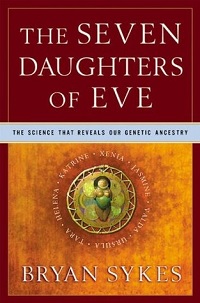 Sykes,
MA, Phd, DSc, University of Oxford. I mentioned that I would be utilizing the DNA program
offered by Oxford Ancestors and would report on the results. I sent my DNA (ten brush
samples taken from my inner cheeks) to England a few weeks ago and recently received their
report. Considering what I know of my ancestors (traced and linked to the mid 1600's), I had no
doubt that I was descended through the maternal line from ancestors living either in the Alpine
regions or slightly east of there. This would put my DNA in what Oxford Ancestors calls "the
clan of Katrine" although there was the possibility that, given western Germanic migration,
it could be the "clan of Helena" which evolved just west of the Alps in France and
Germany. Sykes,
MA, Phd, DSc, University of Oxford. I mentioned that I would be utilizing the DNA program
offered by Oxford Ancestors and would report on the results. I sent my DNA (ten brush
samples taken from my inner cheeks) to England a few weeks ago and recently received their
report. Considering what I know of my ancestors (traced and linked to the mid 1600's), I had no
doubt that I was descended through the maternal line from ancestors living either in the Alpine
regions or slightly east of there. This would put my DNA in what Oxford Ancestors calls "the
clan of Katrine" although there was the possibility that, given western Germanic migration,
it could be the "clan of Helena" which evolved just west of the Alps in France and
Germany. The report states that my DNA mitochondrial sequence definitely matches those of the "clan of Helena" and not the "clan of Katrine." This places my ancestral origin some 20,000 years ago in the region which is now France and Germany. Migration east must have occurred numerous times between that point and the year 1650 when I first identified ancestry in the Burgenland, with indications that there was indeed, previous migration from western Austria, Bavaria, Styria and other Germanic areas. Since most of my ancestors were Germanic through all of the generations that I have linked, this is not a great revelation. That DNA places it on the western side of the Alps, thousands of years ago is an astounding and important revelation. 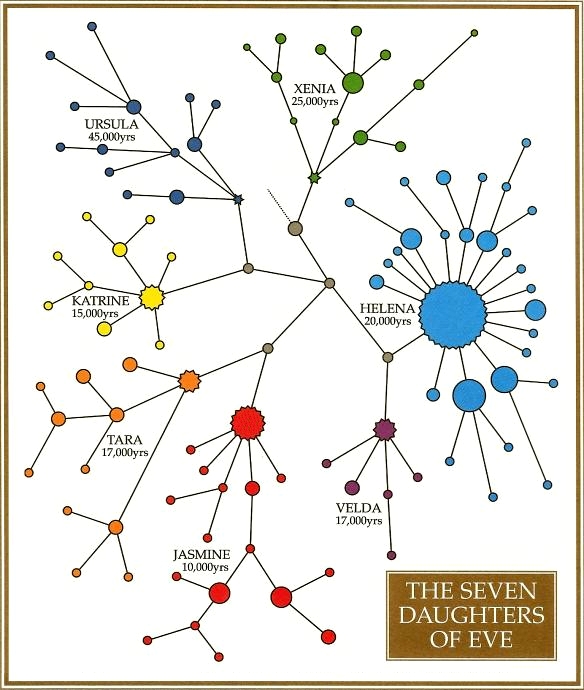 I believe we can deduce from this that most descendants with continuous Germanic maternal ancestors in the Burgenland will show a DNA match with the "clan of Helena" - back 20,000 years ago; Hungarian descendants will probably trace to the "clan of Katrine" - 15,000 years ago and Croat descendants will trace to the "clans of Ursula" - 45,000 years ago or Xenia - 25,000 years ago. Professor Sykes, in his book "The Seven Daughters Of Eve," provides proof of what he calls the "clan of Ursula" migrating from the Mediterranean area northward into Europe about 45,000 years ago, based on DNA and mutational changes over time. Mutations occur on average every 20,000 years. If you have an interest in your DNA sequence, I suggest you read the book and contact Oxford Ancestors. I believe DNA allows us to establish a major ancestral root, but the lack of written records makes it impossible to establish all of the stems or branches. Obtaining your DNA sequence is expensive and the result will not furnish you with a pedigree, but if you ever wondered where you came from, it will provide an answer - at least between 10,000 and 45,000 years ago. You won't get much beyond 400 years checking church records. Once you do have your DNA sequence, you can compare it with others and possibly link to some other lines. This is something I'll be looking into next. Additional comments, Editor: Oxford Ancestors was  a company run by Bryan Sykes, a professor at Oxford University and the author of the book Gerry
mentions, "The Seven Daughters of Eve." I say "was" because the company recently became a
victim of the EU's GDPR (General Data Protection Regulation), choosing to shut
down rather than retool to meet all the data-security requirements of the regulation. It had
already stopped testing, as Dr. Sykes was planning to retire; the GDPR was just the final
straw.
a company run by Bryan Sykes, a professor at Oxford University and the author of the book Gerry
mentions, "The Seven Daughters of Eve." I say "was" because the company recently became a
victim of the EU's GDPR (General Data Protection Regulation), choosing to shut
down rather than retool to meet all the data-security requirements of the regulation. It had
already stopped testing, as Dr. Sykes was planning to retire; the GDPR was just the final
straw.Back then, Oxford Ancestors' mitochondrial test cost $900 and tested only 400 mtDNA locations among the 16,569 locations of the full-sequence test (which FTDNA currently sells for $159 when "on sale"). As such, it was a pitifully inaccurate test, assigning people to one of just 7 branches (clans) on the mitochondrial tree (for comparison, the current [2016] mitochondrial tree has nearly 5,500 documented branches). If there was one sentence I found most humorous in Gerry's article, it was when he said "I believe we can deduce from this that most descendants with continuous Germanic maternal ancestors in the Burgenland will show a DNA match with the "clan of Helena" - back 20,000 years ago." Had I taken the same test back then, my result would have led (just as strongly, if that can be said) to the "Clan of Tara," as my modern, full-sequence test says I'm on that branch (and I can document the Germanic roots of my Burgenland maternal ancestors at least as far back as Gerry could his). Given that The Seven daughter of Eve is now considered incredibly outdated, I can't recommend that you read it, even though it was, at publication, a groundbreaking book. A last thought: Apparently the Oxford Ancestors database and 21 years worth of DNA samples is to be trashed (which is the same fate suffered by the Y and mitochondrial results in the Sorenson Molecular Genealogy Foundation database in 2016 and in the AncestryDNA database in 2015). What this says is that nothing is forever; if you wish to have a record of your tests, download them and preserve them yourself! |
6) ETHNIC EVENTS LEHIGH VALLEY, PA Saturday, August 4: Sommerfest at the Evergreen Heimatbund in Fleetwood. Music by Maria & John. Info: www.evergreenclub.org Sunday, August 5: Parish Picnic & Homecoming at St. Peter's Roman Catholic Church in Coplay. Polka Mass at 10:30 AM. Entertainment by the Emil Schanta Band. Info: www.stpeterchurchcoplay.com Sunday, August 19: German-American Day at the Reading Liederkranz. Entertainment by "Mädeljäger" and local Schuhplattlers and German singing groups. Info: www.readingliederkranz.com Friday-Sunday, August 24-26: Coplay Community Days at Coplay Community Park. Entertainment by the Josef Kroboth Orchestra on Aug. 26.: Info: www.facebook.com/CoplayCommunityDaysFestival NEW BRITAIN, CT Friday, August 3, 7 pm: Heimat Abend. Austrian Donau Club, 545 Arch Street, $3. Music by Frank Billowitz. Friday, August 17, 7:30 pm: Heurigan Abend. Austrian Donau Club, 545 Arch Street, $3. Music by Schachtelgebirger Musikanten. UPPER MIDWEST Sunday, August 5, 12:30 - 5 pm: The Summer Meeting of the Upper Midwest Burgenland Bunch will be held August 5th from 12:30 to 5 pm at the Ramsey County Library, which is at 4560 Victoria St. N, Shoreview, MN. It is also our picnic meeting so bring a dish to share. |
7) BURGENLAND EMIGRANT OBITUARIES Franz "Frank" Simitz  February
5, 1925 - June 1, 2018 February
5, 1925 - June 1, 2018Peacefully with family at his side at Southlake Regional Health Centre, at the age of 93. Born in Burgenland, Austria, immigrated to Canada in 1954, he lived in Richmond Hill for over 50 years and recently, Aurora. Frank was a man who loved the simple pleasures. Tending his beautiful flowers and organic vegetable gardens in Richmond Hill, backyard picnic table gatherings with good friends, and always-his wife's home cooking. He often had a schnapps or wine-making project on the go; notably blueberry wine from hand-picked berries, at some peril, with his family in the Soo. He had a great reverence for nature, and enjoyed the seasons of planting and harvesting reflective of his farming roots in Burgenland, Austria. Upon immigrating to Canada in 1954 Frank took on a trade and was a proud Carpenter's Union Local 27 member for over 50 years; known for his work ethic and perfectionism. He was a very logical and knowledgeable man, who enjoyed numbers, often with a Sudoku in hand, always to be done in ink only; no mistakes allowed! He leaves behind Bibiana, his dedicated wife of 64 years, his children Ernest, Edith Burch (the late Randy), Gertrude Paraskevin (Ken) and Edward. His grandchildren who simply made him beam; Madeline, Emily, Julia and Michael. And his favorite dog, Betty White. Decidedly old-school stern, he mellowed with age and in the end he leaves us these gifts: the love he had for his family, a legacy of honest and determined work, the value of simplicity vs materialism, thinking for oneself, staying aware of global events yet acting locally, and putting away for the future. Thanks Dad! A small, happy ("crying doesn't help") private celebration of life will be held on Saturday July 7 at Thompson Funeral Home in Aurora 12:00-3:00; with planned spoken words about 12:30. In lieu of flowers, Frank would have said "save your money". So if you wish, tend to a plant in his honour, or enjoy a simple pleasure with those you love. Please bring your fond memories to share and be prepared to raise a glass. Prosit! Published in the Toronto Star on July 3, 2018 Justine Hayward (née Oswald)  Justine
Hayward, age 100, of Hawley, Pennsylvania, died Sunday, July 15, 2018. She was preceded in death
by her husband of 52 years, David James Hayward, in 1998. Justine
Hayward, age 100, of Hawley, Pennsylvania, died Sunday, July 15, 2018. She was preceded in death
by her husband of 52 years, David James Hayward, in 1998.Born January 5, 1918, in Jabing, Austria, she was the daughter of the late Wendelin and Justine (Findler) Oswald. Formerly of Queens, NY, she had been a Hawley resident since 1980. A member of BVM Queen of Peace Roman Catholic Church, over the years she had been active with the Altar & Rosary Society, served as a Eucharistic Minister and was a member of the Quilting Club. She was a homemaker and mother, a profession from which she never retired. Her strong faith and belief in the Lord and His ways always provided her with tremendous inner strength and guided her throughout her life. In her free time, she enjoyed gardening and was a wonderful cook whose family loved all her delicious food. She is survived by two daughters: Teresa Austin of Flushing, NY, and Virginia Mancini of Hawley; three sons: James Hayward and his wife Karen of Westbury, NY, David Hayward and his wife Laura of Lincroft, NJ, and Denis Hayward and his wife Wini of Hawley; fourteen grandchildren: Raymond, Sondra, Michelle, Frank, Justin, Christopher, David, Peter, Kelly, Regina, John, Jennifer, Katherine and Nicholas; and eight great grandchildren. She was predeceased by a daughter, Justine O'Connor. Visitation will be held on Wednesday, July 18, from 2:30 to 7 PM at Teeters' East Chapel, 505 Church St., Hawley, PA. A Mass of Christian Burial will be held at 10:00 AM on Thursday, July 19, at BVM Queen Of Peace Roman Catholic Church, 314 Chestnut Ave, Hawley celebrated by Rev. Richard W. Beck, Pastor. Burial will follow in B.V.M. Queen Of Peace Cemetery. Memorials may be made to Covenant House, 460 W. 41st St., New York, NY 10036 (covenanthouse.org) or Anderson Center for Autism, 4885 US 9, Staatsburg, NY 12580 (andersoncenterforautism.org). For additional information or to leave a condolence, please visit www.TeetersFuneralChapel.com. Arrangements were made by Teeters' Funeral Chapel, Inc., 505 Church St., Hawley, PA 18428. Published in Wayne Independent on July 17, 2018 |
| END OF NEWSLETTER (Even good things must end!) |
|
Burgenland Bunch Newsletter, copyright © 2018 by The Burgenland
Bunch |
 News
News I've
blown up part of that fourth image and show it to the right.
I've
blown up part of that fourth image and show it to the right.  The viewer's image count indicates that there are
322 images on the film, which is reasonably consistent with the folio count of 312. The
extra 10 images are the header and trailer pages that LDS added around the "item."
The viewer's image count indicates that there are
322 images on the film, which is reasonably consistent with the folio count of 312. The
extra 10 images are the header and trailer pages that LDS added around the "item." 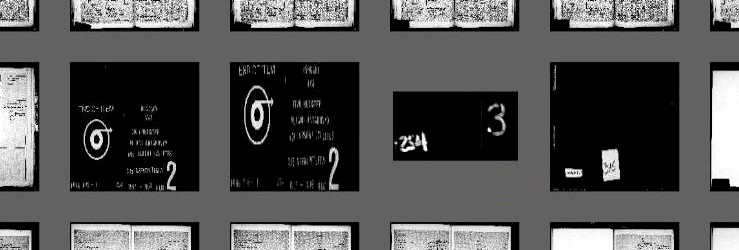
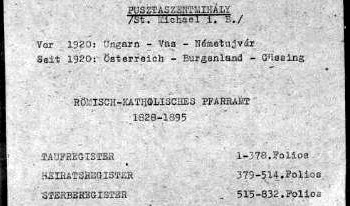 Shown
to the right is an example for a film arranged in the second manner, "by
type." In this case, it is the Pusztaszentmihály / Sankt Michael Catholic records
for 1828-1895. Here we see that the Tauf, Heirats, and Sterbe
registers are presented as three consecutive sections within one item, with ledger pages
(folios) 1-378 being the baptisms, pages 379-514 being the marriages, and pages 515-832
being the deaths.
Shown
to the right is an example for a film arranged in the second manner, "by
type." In this case, it is the Pusztaszentmihály / Sankt Michael Catholic records
for 1828-1895. Here we see that the Tauf, Heirats, and Sterbe
registers are presented as three consecutive sections within one item, with ledger pages
(folios) 1-378 being the baptisms, pages 379-514 being the marriages, and pages 515-832
being the deaths. 
 According
to my dad, people in Burgenland did not celebrate birthdays ...or even take special note of them
when the day came. The saint day for your given name was noted when that occurred during
the year, but not your birthday. Nor did an adult need to know his date of birth. If there was
ever a need to know that date you only had to go to the church to find it in the registry. So
after our Burgenland ancestors came to America and needed to come up with a birth date for some
official purpose, such as a naturalization record, they provided a date but not necessarily the
right one.
According
to my dad, people in Burgenland did not celebrate birthdays ...or even take special note of them
when the day came. The saint day for your given name was noted when that occurred during
the year, but not your birthday. Nor did an adult need to know his date of birth. If there was
ever a need to know that date you only had to go to the church to find it in the registry. So
after our Burgenland ancestors came to America and needed to come up with a birth date for some
official purpose, such as a naturalization record, they provided a date but not necessarily the
right one. whose
shop on Arch Street in New Britain I passed daily on my way to school. John thought he had been
born on 29 Sep 1893. That’s the date he used in his Word War I draft registration in 1917
and also in his naturalization record in 1922. But the Sankt Martin an der Raab church records
show he was actually born on 2 Dec 1893 and baptized the next day.
whose
shop on Arch Street in New Britain I passed daily on my way to school. John thought he had been
born on 29 Sep 1893. That’s the date he used in his Word War I draft registration in 1917
and also in his naturalization record in 1922. But the Sankt Martin an der Raab church records
show he was actually born on 2 Dec 1893 and baptized the next day.  Den
Geburtstag—31. Juli—habe ich mir erst später aus dem Pfarrbuche zu Krieglach
heraussuchen lassen, denn bei uns daheim wurde nur mein Namenstag, Petri Kettenfeier, am 1.
August, und zwar allemal dadurch gefeiert, dass mir meine Mutter an diesem Tage einen
Eierkuchen buk.”
Den
Geburtstag—31. Juli—habe ich mir erst später aus dem Pfarrbuche zu Krieglach
heraussuchen lassen, denn bei uns daheim wurde nur mein Namenstag, Petri Kettenfeier, am 1.
August, und zwar allemal dadurch gefeiert, dass mir meine Mutter an diesem Tage einen
Eierkuchen buk.”